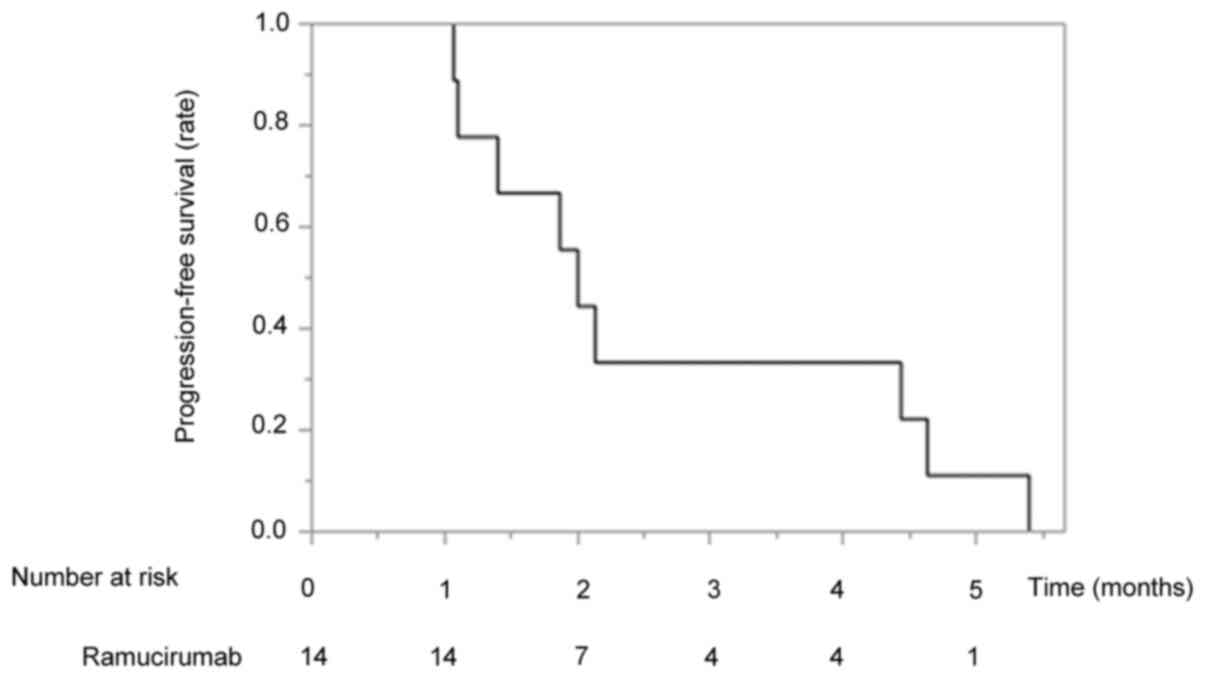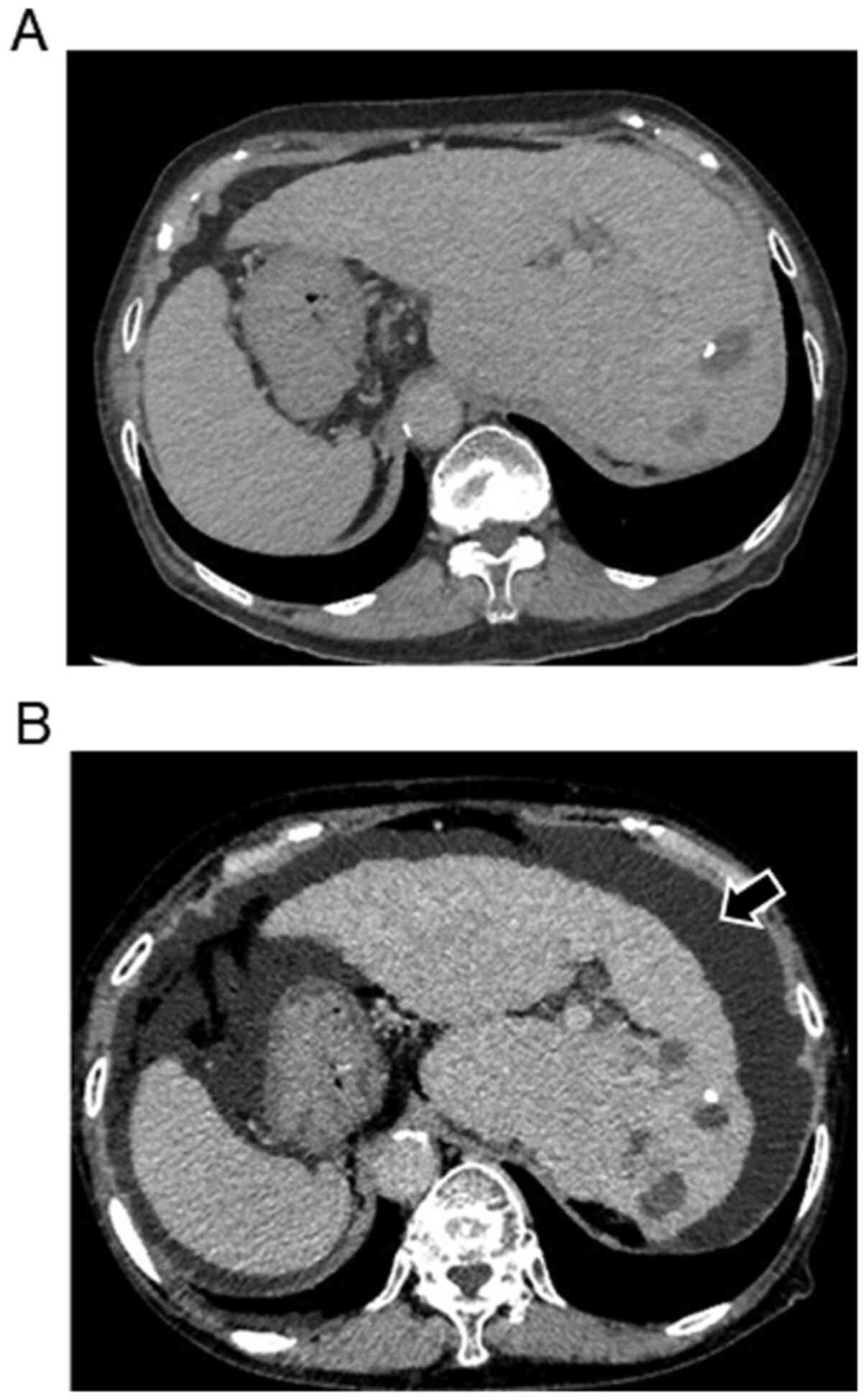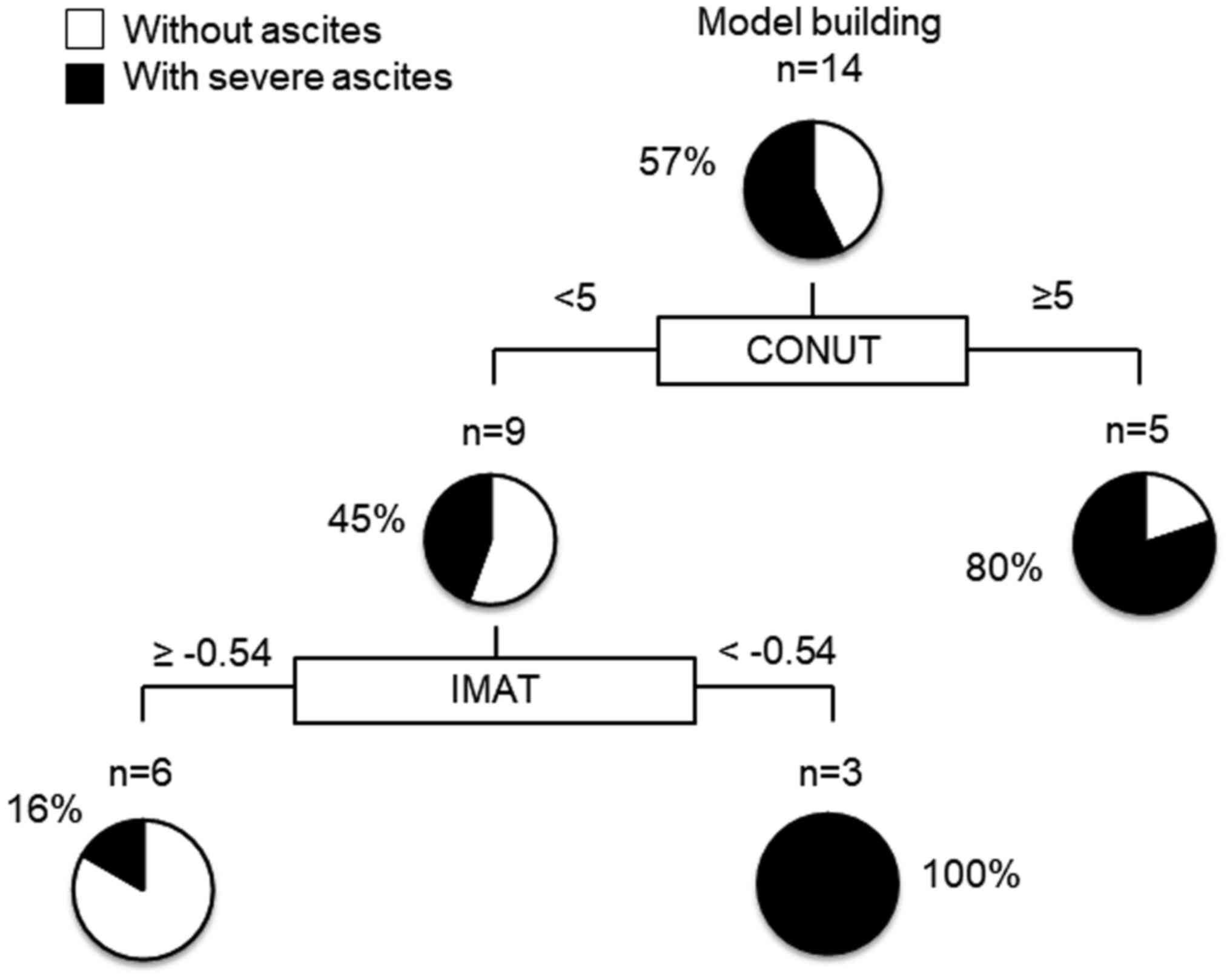|
1
|
Global Burden of Disease Liver Cancer C.
Akinyemiju T, Abera S, Ahmed M, Alam N, Alemayohu MA, Allen C,
Al-Raddadi R, Alvis-Guzman N, Amoako Y, et al: The burden of
primary liver cancer and underlying etiologies from 1990 to 2015 at
the Global, Regional, and National Level: Results from the global
burden of disease study 2015. JAMA Oncol. 3:1683–1691.
2017.PubMed/NCBI View Article : Google Scholar
|
|
2
|
European Association for the study of the
liver. Electronic address simpleeasloffice@easloffice.eu;
European association for the study of the liver. EASL clinical
practice guidelines: Management of hepatocellular carcinoma. J
Hepatol. 69:182–236. 2018.PubMed/NCBI View Article : Google Scholar
|
|
3
|
Kudo M, Finn RS, Qin S, Han KH, Ikeda K,
Piscaglia F, Baron A, Park JW, Han G, Jassem J, et al: Lenvatinib
versus sorafenib in first-line treatment of patients with
unresectable hepatocellular carcinoma: A randomised phase 3
non-inferiority trial. Lancet. 391:1163–1173. 2018.PubMed/NCBI View Article : Google Scholar
|
|
4
|
Bruix J, Qin S, Merle P, Granito A, Huang
YH, Bodoky G, Pracht M, Yokosuka O, Rosmorduc O, Breder V, et al:
Regorafenib for patients with hepatocellular carcinoma who
progressed on sorafenib treatment (RESORCE): A randomised,
double-blind, placebo-controlled, phase 3 trial. Lancet. 389:56–66.
2017.PubMed/NCBI View Article : Google Scholar
|
|
5
|
Llovet JM, Ricci S, Mazzaferro V, Hilgard
P, Gane E, Blanc JF, de Oliveira AC, Santoro A, Raoul JL, Forner A,
et al: Sorafenib in advanced hepatocellular carcinoma. N Engl J
Med. 359:378–390. 2008.PubMed/NCBI View Article : Google Scholar
|
|
6
|
Zhu AX, Kang YK, Yen CJ, Finn RS, Galle
PR, Llovet JM, Assenat E, Brandi G, Pracht M, Lim HY, et al:
Ramucirumab after sorafenib in patients with advanced
hepatocellular carcinoma and increased α-fetoprotein concentrations
(REACH-2): A randomised, double-blind, placebo-controlled, phase 3
trial. Lancet Oncol. 20:282–296. 2019.PubMed/NCBI View Article : Google Scholar
|
|
7
|
Zhu AX, Baron AD, Malfertheiner P, Kudo M,
Kawazoe S, Pezet D, Weissinger F, Brandi G, Barone CA, Okusaka T,
et al: Ramucirumab as second-line treatment in patients with
advanced hepatocellular carcinoma: Analysis of REACH trial results
by child-pugh score. JAMA Oncol. 3:235–243. 2017.PubMed/NCBI View Article : Google Scholar
|
|
8
|
Cheung K, Lee SS and Raman M: Prevalence
and mechanisms of malnutrition in patients with advanced liver
disease, and nutrition management strategies. Clin Gastroenterol
Hepatol. 10:117–125. 2012.PubMed/NCBI View Article : Google Scholar
|
|
9
|
Shimose S, Kawaguchi T, Iwamoto H, Tanaka
M, Miyazaki K, Ono M, Niizeki T, Shirono T, Okamura S, Nakano M, et
al: Controlling nutritional status (CONUT) score is associated with
overall survival in patients with unresectable hepatocellular
carcinoma treated with lenvatinib: A multicenter cohort study.
Nutrients. 12(1076)2020.PubMed/NCBI View Article : Google Scholar
|
|
10
|
Chavez-Tostado M, Cervantes-Guevara G,
Lopez-Alvarado SE, Cervantes-Pérez G, Barbosa-Camacho FJ,
Fuentes-Orozco C, Hernández-Corona DM, González-Heredia T,
Cervantes-Cardona GA and González-Ojeda A: Comparison of
nutritional screening tools to assess nutritional risk and predict
clinical outcomes in Mexican patients with digestive diseases. BMC
Gastroenterol. 20(79)2020.PubMed/NCBI View Article : Google Scholar
|
|
11
|
Takagi K, Umeda Y, Yoshida R, Nobuoka D,
Kuise T, Fushimi T, Fujiwara T and Yagi T: Preoperative controlling
nutritional status score predicts mortality after hepatectomy for
hepatocellular carcinoma. Dig Surg. 36:226–232. 2019.PubMed/NCBI View Article : Google Scholar
|
|
12
|
Ogawa M, Lester R, Akima H and Gorgey AS:
Quantification of intermuscular and intramuscular adipose tissue
using magnetic resonance imaging after neurodegenerative disorders.
Neural Regen Res. 12:2100–2105. 2017.PubMed/NCBI View Article : Google Scholar
|
|
13
|
Fujiwara N, Nakagawa H, Kudo Y, Tateishi
R, Taguri M, Watadani T, Nakagomi R, Kondo M, Nakatsuka T, Minami
T, et al: Sarcopenia, intramuscular fat deposition, and visceral
adiposity independently predict the outcomes of hepatocellular
carcinoma. J Hepatol. 63:131–140. 2015.PubMed/NCBI View Article : Google Scholar
|
|
14
|
Harimoto N, Hoshino H, Muranushi R,
Hagiwara K, Yamanaka T, Ishii N, Tsukagoshi M, Igarashi T, Watanabe
A, Kubo N, et al: Skeletal muscle volume and intramuscular adipose
tissue are prognostic predictors of postoperative complications
after hepatic resection. Anticancer Res. 38:4933–4939.
2018.PubMed/NCBI View Article : Google Scholar
|
|
15
|
Forner A, Reig M and Bruix J:
Hepatocellular carcinoma. Lancet. 391:1301–1314. 2018.PubMed/NCBI View Article : Google Scholar
|
|
16
|
Johnson PJ, Berhane S, Kagebayashi C,
Satomura S, Teng M, Reeves HL, O'Beirne J, Fox R, Skowronska A,
Palmer D, et al: Assessment of liver function in patients with
hepatocellular carcinoma: A new evidence-based approach-the ALBI
grade. J Clin Oncol. 33:550–558. 2015.PubMed/NCBI View Article : Google Scholar
|
|
17
|
Koya S, Kawaguchi T, Hashida R, Hirota K,
Bekki M, Goto E, Yamada M, Sugimoto M, Hayashi S, Goshima N, et al:
Effects of in-hospital exercise on sarcopenia in hepatoma patients
who underwent transcatheter arterial chemoembolization. J
Gastroenterol Hepatol. 34:580–588. 2019.PubMed/NCBI View Article : Google Scholar
|
|
18
|
Sinclair M, Gow PJ, Grossmann M and Angus
PW: Review article: Sarcopenia in cirrhosis-aetiology, implications
and potential therapeutic interventions. Aliment Pharmacol Ther.
43:765–777. 2016.PubMed/NCBI View Article : Google Scholar
|
|
19
|
Schneider CA, Rasband WS and Eliceiri KW:
NIH Image to ImageJ: 25 years of image analysis. Nat Methods.
9:671–675. 2012.PubMed/NCBI View Article : Google Scholar
|
|
20
|
Hirota K, Kawaguchi T, Koya S, Nagamatsu
A, Tomita M, Hashida R, Nakano D, Niizeki T, Matsuse H, Shiba N and
Torimura T: Clinical utility of the liver frailty index for
predicting muscle atrophy in chronic liver disease patients with
hepatocellular carcinoma. Hepatol Res. 50:330–341. 2020.PubMed/NCBI View Article : Google Scholar
|
|
21
|
Kitajima Y, Takahashi H, Akiyama T,
Murayama K, Iwane S, Kuwashiro T, Tanaka K, Kawazoe S, Ono N,
Eguchi T, et al: Supplementation with branched-chain amino acids
ameliorates hypoalbuminemia, prevents sarcopenia, and reduces fat
accumulation in the skeletal muscles of patients with liver
cirrhosis. J Gastroenterol. 53:427–437. 2018.PubMed/NCBI View Article : Google Scholar
|
|
22
|
Hamaguchi Y, Kaido T, Okumura S, Kobayashi
A, Shirai H, Yao S, Yagi S, Kamo N, Seo S, Taura K, et al:
Preoperative visceral adiposity and muscularity predict poor
outcomes after hepatectomy for hepatocellular carcinoma. Liver
Cancer. 8:92–109. 2019.PubMed/NCBI View Article : Google Scholar
|
|
23
|
Lencioni R and Llovet JM: Modified RECIST
(mRECIST) assessment for hepatocellular carcinoma. Semin Liver Dis.
30:52–60. 2010.PubMed/NCBI View Article : Google Scholar
|
|
24
|
Shimose S, Tanaka M, Iwamoto H, Niizeki T,
Shirono T, Aino H, Noda Y, Kamachi N, Okamura S, Nakano M, et al:
Prognostic impact of transcatheter arterial chemoembolization
(TACE) combined with radiofrequency ablation in patients with
unresectable hepatocellular carcinoma: Comparison with TACE alone
using decision-tree analysis after propensity score matching.
Hepatol Res. 49:919–928. 2019.PubMed/NCBI View Article : Google Scholar
|
|
25
|
Yoshiji H, Kuriyama S, Hicklin DJ, Huber
J, Yoshii J, Ikenaka Y, Noguchi R, Nakatani T, Tsujinoue H and
Fukui H: The vascular endothelial growth factor receptor KDR/Flk-1
is a major regulator of malignant ascites formation in the mouse
hepatocellular carcinoma model. Hepatology. 33:841–847.
2001.PubMed/NCBI View Article : Google Scholar
|
|
26
|
Tabernero J, Takayuki Y and Cohn AL:
Correction to Lancet Oncol 2015; 16: 499-508. Ramucirumab versus
placebo in combination with second-line FOLFIRI in patients with
metastatic colorectal carcinoma that progressed during or after
first-line therapy with bevacizumab, oxaliplatin, and a
fluoropyrimidine (RAISE): A randomised, double-blind, multicentre,
phase 3 study. Lancet Oncol. 16(e262)2015.PubMed/NCBI View Article : Google Scholar
|
|
27
|
Wilke H, Muro K, Van Cutsem E, Oh SC,
Bodoky G, Shimada Y, Hironaka S, Sugimoto N, Lipatov O, Kim TY, et
al: Ramucirumab plus paclitaxel versus placebo plus paclitaxel in
patients with previously treated advanced gastric or
gastro-oesophageal junction adenocarcinoma (RAINBOW): A
double-blind, randomised phase 3 trial. Lancet Oncol. 15:1224–1235.
2014.PubMed/NCBI View Article : Google Scholar
|
|
28
|
Saito A, Amiya E, Hatano M, Shiraishi Y,
Nitta D, Minatsuki S, Maki H, Hosoya Y, Tsuji M, Bujo C, et al:
Controlling nutritional status score as a predictive marker for
patients with implantable left ventricular assist device. ASAIO J.
66:166–172. 2020.PubMed/NCBI View Article : Google Scholar
|
|
29
|
Vidot H, Bowen DG, Carey S, McCaughan GW,
Allman-Farinelli M and Shackel NA: Aggressive nutrition
intervention reduces ascites and frequency of paracentesis in
malnourished patients with cirrhosis and ascites. JGH Open.
1:92–97. 2017.PubMed/NCBI View Article : Google Scholar
|
|
30
|
Bernardi M, Angeli P, Claria J, Moreau R,
Gines P, Jalan R, Caraceni P, Fernandez J, Gerbes AL, O'Brien AJ,
et al: Albumin in decompensated cirrhosis: New concepts and
perspectives. Gut. 69:1127–1138. 2020.PubMed/NCBI View Article : Google Scholar
|
|
31
|
Zhao LY, Yang DD, Ma XK, Liu MM, Wu DH,
Zhang XP, Ruan DY, Lin JX, Wen JY, Chen J, et al: The prognostic
value of aspartate aminotransferase to lymphocyte ratio and
systemic immune-inflammation index for overall survival of
hepatocellular carcinoma patients treated with palliative
treatments. J Cancer. 10:2299–2311. 2019.PubMed/NCBI View Article : Google Scholar
|
|
32
|
Hamaguchi Y, Kaido T, Okumura S, Kobayashi
A, Fujimoto Y, Ogawa K, Mori A, Hammad A, Hatano E and Uemoto S:
Muscle steatosis is an independent predictor of postoperative
complications in patients with hepatocellular carcinoma. World J
Surg. 40:1959–1968. 2016.PubMed/NCBI View Article : Google Scholar
|
|
33
|
Addison O, Ryan AS, Blumenthal J and Prior
SJ: Increased intramuscular adipose tissue is related to increased
capillarization in older adults. J Frailty Aging. 9:134–138.
2020.PubMed/NCBI View Article : Google Scholar
|
|
34
|
Solomon TP, Haus JM, Li Y and Kirwan JP:
Progressive hyperglycemia across the glucose tolerance continuum in
older obese adults is related to skeletal muscle capillarization
and nitric oxide bioavailability. J Clin Endocrinol Metab.
96:1377–1384. 2011.PubMed/NCBI View Article : Google Scholar
|
|
35
|
Ferguson JW, Dover AR, Chia S, Cruden NL,
Hayes PC and Newby DE: Inducible nitric oxide synthase activity
contributes to the regulation of peripheral vascular tone in
patients with cirrhosis and ascites. Gut. 55:542–546.
2006.PubMed/NCBI View Article : Google Scholar
|
|
36
|
Angeli P, Fernandez-Varo G, Dalla Libera
V, Fasolato S, Galioto A, Arroyo V, Sticca A, Guarda S, Gatta A and
Jiménez W: The role of nitric oxide in the pathogenesis of systemic
and splanchnic vasodilation in cirrhotic rats before and after the
onset of ascites. Liver Int. 25:429–437. 2005.PubMed/NCBI View Article : Google Scholar
|

















